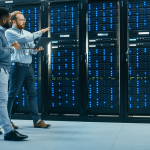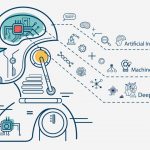There is no doubt that large datasets are essential for creating successful machine learning (or ML) models, regardless of whether data scientists or machines create them. Furthermore, with increasing dataset sizes, ML models’ performance scaling peaks before lags or bottlenecks emerge.
Machine Learning is a hot topic in many domains, with applications across multiple environments and practical use cases. For example, accurate predictions are made from large volumes of data using artificial neural networks (or ANNs) with machine learning. Essentially, machine learning demands a lot of computational power – which also means best-in-class hardware.
Also Read – How Artificial Intelligence Works and Why GPU for AI?
Typically, these hardware components will either be conventional CPUs (central processing units) or GPUs (graphic processing units). With the machine learning models that use rich datasets, which of these technologies performs better? Let’s take a closer look at these technological advances.
CPUs and GPUs: A brief introduction
In computers and computing devices, CPUs, introduced by Intel in 1970, acts as the brain. CPUs have performed logical, computational, or input-output operations without any speed or performance bottlenecks. There was originally only one core of CPU technology – one function at a time.
With technological advancements and a growing need for computing power, we began to see CPUs with dual (or even multiple) cores that performed more than one operation simultaneously. However, CPUs today are almost always based on a few cores, offering reliable computational power just enough to solve a few complex computations- for example, a machine learning problem that requires the interpretation of complex code logic.
Also Read – Benefits of Using Dedicated Server with Nvidia GPU
GPUs also process instructions in computers, just as CPUs do. However, GPUs, thanks to parallelization, can process multiple instructions simultaneously. CPUs have much higher clock speeds than GPUs since they have many cores to process information. As a result of GPUs’ multiple processing capabilities, they can parallelize calculations by using many threads, resulting in a higher execution rate than CPUs.
Graphics processing units are smaller but have more cores, consisting of arithmetic logic units (ALUs), control units, and memory caches. In addition, a GPU is a specialized chip that performs floating-point operations – part of the processes typically present in graphics processing. Graphics processing units have also been around since the 1970s but were mainly used for gaming. However, NVIDIA’s GeForce server products brought it mainstream popularity.
From being initially used for rendering graphics, GPUs eventually began to be used for advanced geometrical calculations. In addition, parallel computing was introduced to GPUs with NVIDIA’s CUDA technology in 2006, increasing the efficiency of computing applications. The benefits of using CUDA in GPU acceleration applications include the ability to run sequential workloads on the CPU (for single-thread performance). In contrast, compute-intensive tasks are run in parallel on thousands of GPU processors.
What is more effective for machine learning: CPUs or GPUs?
GPUs and CPUs both perform calculations and calculations with neural networks. Parallel computing is what makes GPUs more efficient from a computational standpoint. Machine-learning frameworks like TensorFlow utilize multiple CPU resources, reducing the computation time for various threads.
It is easy for most data scientists to connect to Windows Cloud or Linux Cloud servers. E2E Networks, for example, enables CPU-intensive workloads across multiple industry verticals through its cloud services.
A machine learning model is one of the most resource-intensive machine learning models in advanced neural networks. Data is fed into neural networks during training, and hidden layers are employed to process the input, generating a prediction by updating the weights in the hidden layers. Adapting weights based on input data helps locate patterns in forecasts. Known as matrix multiplications, these operations multiply matrices by matrices.
Know More – Dedicated Server USA
Using any CPU-based computer, you can train neural networks to deal with databases that have 1000 to 100,000 parameters in just minutes (or even just a few hours). In contrast, training neural networks that handle over 10 or 50 billion parameters would take years to train on a computer. GPU processors can significantly reduce training time and process data faster.
GPUs allow machine learning models to be trained faster? The only way to run all operations simultaneously is through parallel computing. On GPUs, fewer transistors are allocated to caching and flow control than on CPUs. Thus, GPUs are better suited for quicker data science or machine learning models – whose speed can be boosted by parallel computing. As we advance in this blog post, we will explore the best GPUs for machine learning to make a difference.
Which are the Best GPUs for Machine Learning?
Choosing the right GPU for your data project is crucial for its success. Some of the fastest GPUs on the market are available with machine learning platforms such as TensorFlow and PyTorch. To improve the overall performance of your data project, these GPUs from NVIDIA might be of help to you:
- NVIDIA Titan – With these GPUs, you can handle any entry-level machine learning project with ease. A consumer GPU is almost exclusively used to plan or test data models, which are relatively simple tasks.
Currently, ML workloads are mainly deployed on the Titan RTX GPU.
Also Read – Dedicated Server with Multiple IPs – /26, /25, /24, /22, /21, /20, /19
- NVIDIA Tesla – Large-scale AI and machine learning projects and data centers are ideal for the NVIDIA Tesla GPU series. A GPU in this series supports GPU acceleration and tensor operations, making it possible to use it for machine learning and high-performance computing.
Data analytics and scientific computing are typically performed with NVIDIA K80.
- NVIDIA DGX – For machine learning projects at the enterprise level, this is the most popular GPU series. It offers machine learning support and NVIDIA’s solutions to integrate seamlessly with machine learning and scalability.
If you are looking for an enterprise-grade GPU dedicated server for your machine learning applications, get in touch with Hostrunway’s team of experts today for hassle-free server implementations globally.



